It might take about 6 or 7 hours total to do it if you haven’t done this before. If you car has rear discs and have to remove a bunch of stuff to get the axleshafts out if might take longer. Once you’ve done it once, it will only take a couple hours.
The plates came from the dealer. You need two sets. For the performance rebuild, you’ll need three sets. The standard rebuild uses the plates in the following order: CPPCPPC (where C is a clutch plate and P is a driven plate). To get harder lockup, change the order to CPCPCPC. You buy the third set to get more clutch plates.
Presoak the plates in gear oil overnight. If you don’t do this, you’ll get some SERIOUS locking action for quite a while until the clutch plates absorb the oil.
You may want to grind the friction material off the clutch plates and stuffing as many plates in there as possible. You might like the results, and it’s cheaper too, you can just use your old plates and buy one more set so you’ll have enough plates pack the limited slip tightly.
I assume you know how to remove the differential cover and the axleshafts. If not, refer to your Capri manual, or elsewhere on this site if I have it listed.
You need to get the s-spring out, which you can do with vise-grips and maybe whacking the s-spring with a soft hammer. If you have the stock rear gear, you shouldn’t have problems getting the s-spring out.
People with 3.55s may have trouble, because the ring gear may be too thick for the s-spring to clear.
Once the s-spring is out, you need to rotate the spider gears out. The easiest way to do this is by putting the tranny in gear and inserting an axleshaft to apply torque. Be sure to keep track of the spider gear bearing cups. After that, the side gears just come right out. Remove all the plates, but leave the shims in. Put your new plates in, and put the side gears back in. Now comes one of the tricky parts: getting the spider gears back in. First let me mention that ford has a special tool to measure the clutch pack and tell you what shims you need to use. You don’t have to use this. Generally, if you can get the spider gears to rotate back in with their bearing cups, it won’t be too tight. Both spider gears need to rotate back in at the same. As before, use an axleshaft to make the side gear rotate so you can get the spider gears back in. It may take you several tries. If you can’t do it at all, take out the side gears and remove shims.
There are 4 plates which are splined to the spider gear which drives the axle. These are the “driven” plates. they’re also bare steel. The “friction plates” are the “clutch plates”. The thickness of the clutch stack matters. If it is too tall, you will not be able to get the cross pin into the diff. Before you go through the hassle of re-installing the “S” spring, make sure you can get the cross pin into the diff with the axles and c-clips in place obviously. Before you reinstall the S-spring, measure the clearance between the cross pin and the axleshaft ends. ford specifies 0.005″-0.030″. A good set up would probably be around 0.0025″ on both sides. If you have zero or slightly negative clearance initially, you can simply used sandpaper on the ends of the axleshafts to remove a few thousandths. It doesn’t take much sanding at all. You shouldn’t go much lower than 0.0025″ clearance, because when the parts get hot, they’ll expand and clearances will shrink. you don’t want negative clearance – that can lead to broken parts.
You might even want to try installing 5 clutches per side in your traction-lock. Here are a few quick tips to do it.
- Separate the pacs by side.
- Grind all of the friction material from 5 clutches (requires extras)
- Eliminate extra spacers. Configure it as follows : clutch/spacer/clutch/spacer/clutch/spacer/clutch/spacer/clutch, do not use any shims.
- Re-assembly will be tight. Walking the side gears in will require taking up slack in the cluch pac by prying outwards on an axle.
- Insert crosspin, and retaining bolt. The cluch pacs will be pre-loaded somewhat by the crossbolt. it will be *very* tight. You may want to sand down the ends of the axle shafts a little to make it a little better.
When reinstalling the spider gears, make the diff as tight as you can make it and still be able to rotate the spider gears back in by hand. If you have to use a wrench or crowbar to get the side gears back in, that’s too tight. This means you are going to wind up with a spool. Reduce the stack heights on both sides, and try again. you should be able to rotate the spider gears back in by hand. I’d try changing the driven plates first, as you considered doing. If that doesn’t work, take out the shims. Some people do not use shims at all and it seams to work fine. You might find, depending on how your are setting up your traction-lok that you can’t even get close to getting the spider gears in if you use the shims. It might even be too tight without the shims! In this case you can to sand a few thousandths off the axleshaft ends.
Note however, you don’t have to put the S-spring back in. Some people leave it out so that under zero-power conditions, the unit will differentiate more freely. If you leave the S-spring in, you’ll always have some drag from the pressure of the S-spring. Others have been known to put in stiffer S-springs, which you can get from a Ranger.
I don’t know if this modification works or not because when you’re on the gas, the mechanical force on the clutch packs resulting from applied power will far exceed the force produced by the S-spring. You’re going to have more drag under zero-power conditions, such as corner entry, which will result in more understeer from the rear wheels trying to go straight. The main benefit of the stiffer S-spring is that the increased preload makes it easier for the differential to lock up under extreme low-traction conditions.
If you want the S-spring back in, you can compress it with vise-grips and tapped it back in with a rubber mallet. It may takes a few tries to get it in. After that, put the cross-pin back in. Don’t forget the cross-pin locking bolt! Use loctite on it – you definitely do not want the cross-pin to come out.
No special tools are required. You’ll probably have some chatter for a while, but it will quiet down after about a week’s worth of driving. If you find it to be too tight, add some friction modifier.
Do you need to use the friction modifier?
The purpose of the friction modifier is to REDUCE, not increase, the friction between the plates. You will need “some” friction modifier. If you rebuild a t-lock without friction modifier it will sound like you left a wrench in the diff when you try to turn a corner. In extreme cases, it will be like driving with a spool. Very abrupt and unpredictable locking and slipping chatter in when cornering. Start with 1/3 – 1/2 bottle and fine tune from there.
You might use regular 90W dino oil and 1/2 bottle of friction modifier to keep the noise down but without sacrificing grip. Don’t have any basis for this other than some people have tried it and it’s working. You also might want to keep the old clutch plates since you may not always have the proper shims. Keep swapping old plates and new ones, and any shims in the kit, until you can barely get the assembly back in the case. Then you know it’s tight. You don’t have to rely on the s-spring to preload the clutch stacks, its there just to keep the c-clips in place.
I have found that using a full synthetic gear lube eliminates the need for the friction modifier.
I’d recommend replacing the axleshaft bearing seals while you’re at it. They’re only a few dollars each, and I’ve had to replace them a number of times. Then again, an autocross course may not impose the kind of extended cornering loads that a road course does, causing all the gear oil to move over to one side of the axle and dribble out of the leaky axle seal. Just be sure you don’t damage the seals in the process of removing and inserting the axleshafts.
5.0 Mustang & Super Fords Magazine
Give your Traction-Lok differential a new lease on life with FRPP’s new carbon-fiber upgrade – May 2007
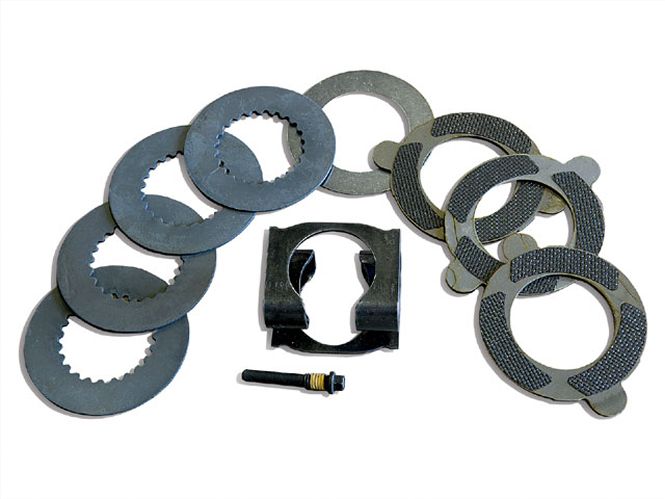
This is the new carbon rebuild kit for the 8.8-inch Traction-Lok limited-slip differential. It’s available from Ford Racing Performance Parts (PN M-4700-C). The guys at FRPP recommended this kit for improved durability, especially in high-horsepower and racing applications.

The fluid had probably been in this differential for 10 years and 110,000 miles. Dan cleaned it and kept it off himself by repeatedly spraying it with brake cleaner and scraping runny mixture into the drain pan.
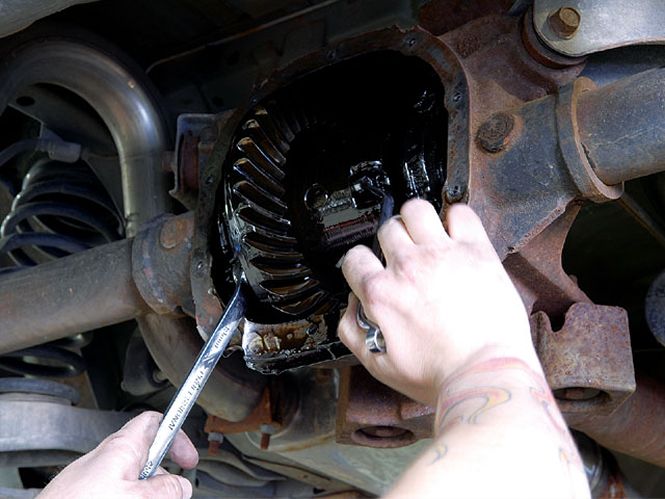
Remove the center-pin lock bolt. Put a wrench on one of the bolts holding the ring gear to the differential to keep it from moving. Now you can remove the center pin and axle C-clips.
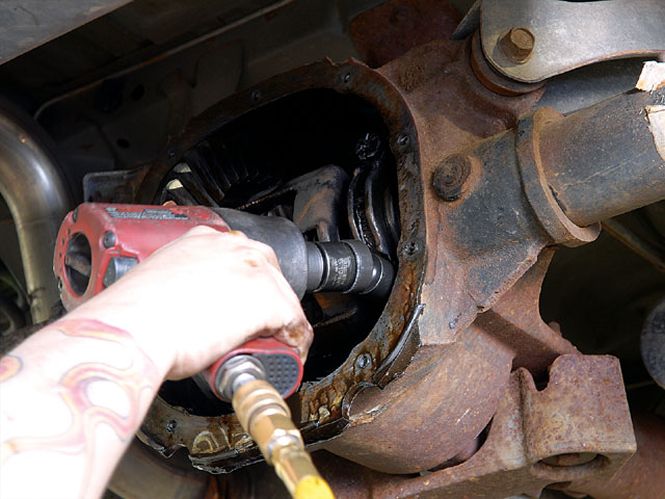
Remove the end caps holding the differential in place. Mark the caps and bolts so you can put them back the same way they came out.
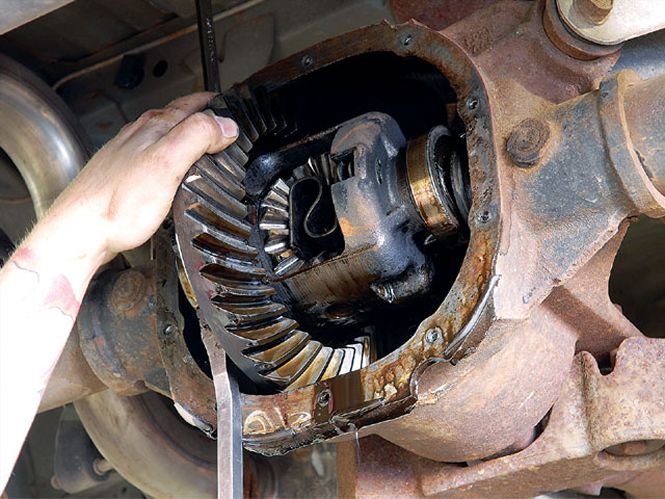
Now the differential should be ready to come out. It isn’t light, so you may have to pry it out, as shown. Watch out for additional fluid left in, on, and around the differential. Clean the empty axle housing with more brake cleaner.

With the differential on a clean workbench, hit the ring-gear bolts with an air ratchet. If the differential moves around too much, you can put it in a vise. Remove the ring gear and inspect it for damage if you’re reusing it.

With the S-spring out, you should be able to remove the spider gears one at a time. They should spin right out.

Finally, remove the side gears from each side. The friction plates, steel reaction plates, and shims-an assembly called the clutch pack-should come out with them. This is a filthy and smelly job, so Dan recommends rubber gloves.

During the disassembly, Dan noted that there was quite a bit of play in the spider and end gears. It turned out that so much material had worn off the friction plates (left) and steel reactor plates (right) that the assembly was no longer held together tightly. Note the total lack of friction material and the grooves worn into both plates-this Traction-Lok was not functioning properly.

This is the order that Ford recommends you stack the friction and steel plates. For reference, starting from right to left, it goes steel, friction, steel, steel, friction, steel, friction, and shim. Some enthusiasts use different orders and even extra friction plates for a tighter differential, but we haven’t tested these methods with the new carbon-fiber friction plates.

Soak all the friction plates in Ford’s XL-3 friction modifier for 15 minutes. No friction modifier was included in the M-4700-C kit, but it is available from your local Ford dealer.
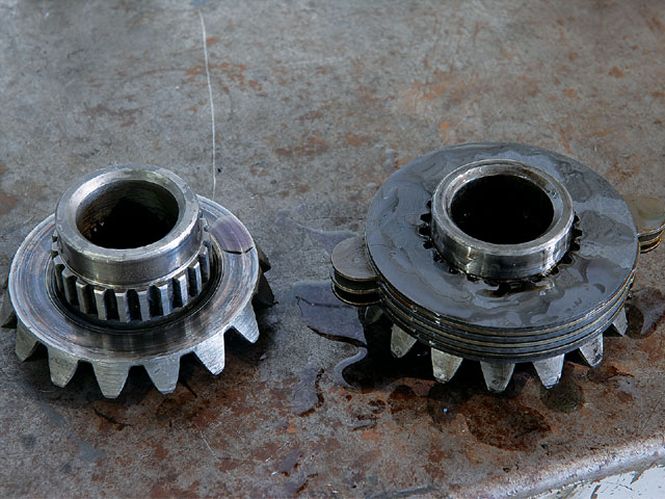
Keep each set of friction plates, steel plates, and shims together, as they come premeasured and matched. Each set goes on one of the side gears. You might not be able to see it in this picture, but the side gears are splined to fit over the axles.
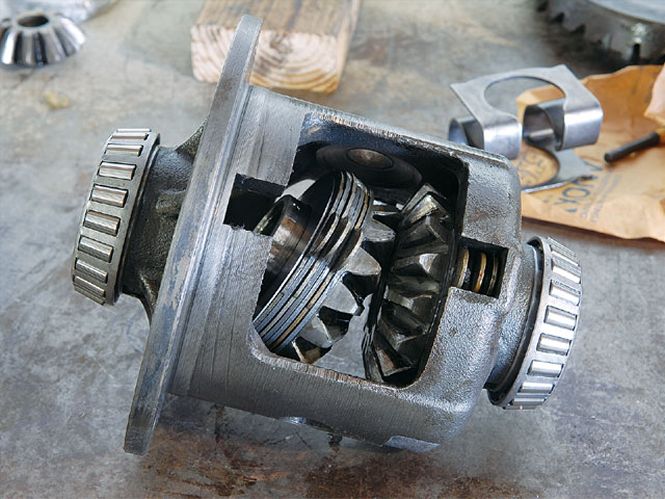
Install the clutch-pack and side-gear assemblies back into the differential. Ford recommends starting with the left side.
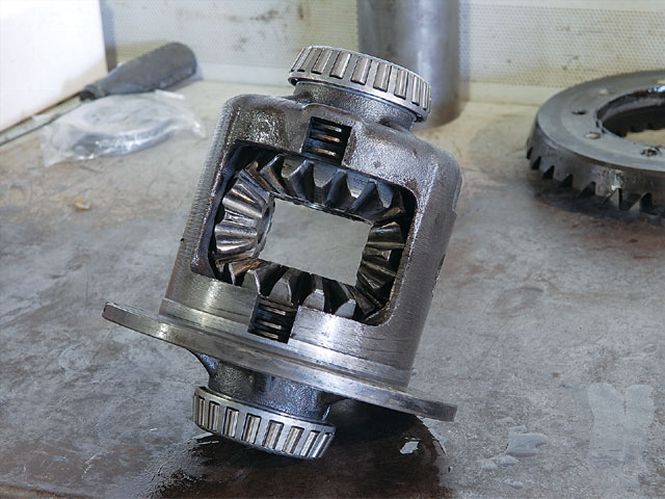
Next come the two spider gears. They spin back in as easily as they came out.

Finally, press the new spring into place, completing the Traction-Lok assembly. Some people use a rubber hammer to force the spring, while others compress it in a vise or with pliers first.
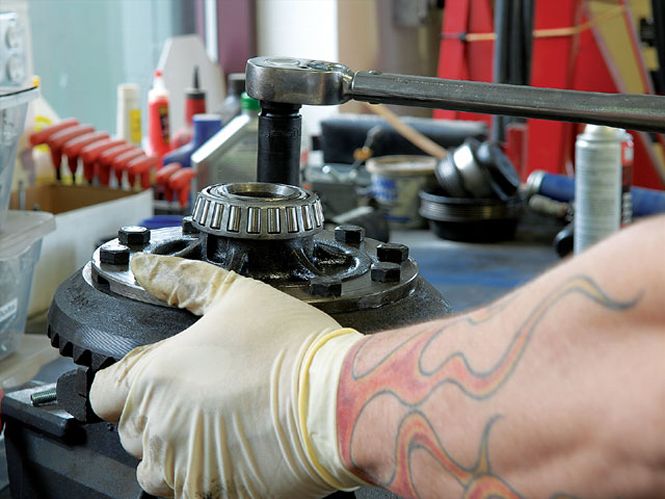
Bolt the ring gear back onto the differential using a vise. Torque the bolts to 70-85 lb-ft using a crisscross pattern.

Reinstall the rebuilt differential, complete with its carrier bearings and races. Put the caps and their bolts back where they came from, and torque the cap bolts to 70-85 lb-ft.
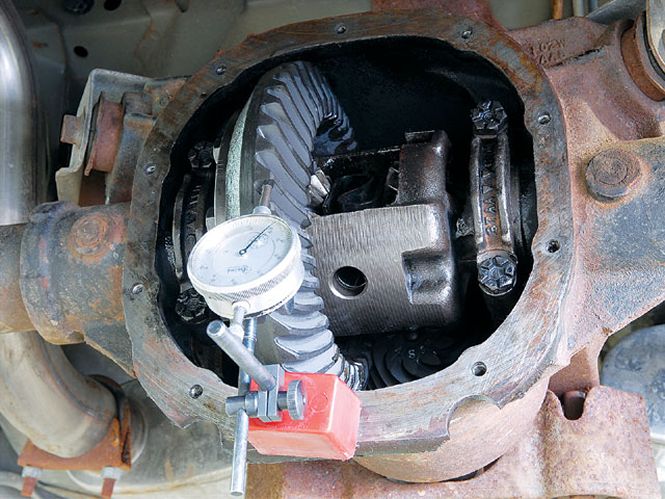
Though we had all shims and bearings reinstalled the way we found them, Dan still checked the backlash using this dial-indicator setup just in case. If your backlash isn’t within 0.008 to 0.012 inch, add or subtract different amounts of side carrier shims.
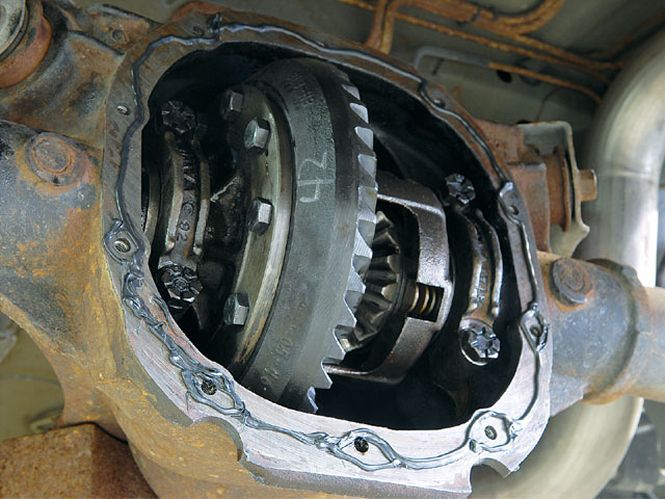
First clean off all the old gasket and gasket sealer from the differential housing. Dan recommends using only silicone gasket maker instead of the rubber gasket supplied with the new diff cover. The gaskets have a tendency to compress later, allowing leaks and causing the bolts to loosen.

We installed the FRPP diff cover (PN M-4033-G1) before the silicone dried and tightened the bolts to 20-25 lb-ft in a crisscross pattern. The thickness of this aluminum cover adds strength to the housing.
These special load bolts also support the main caps, which are under stress during launching and accelerating. Torque the load bolts to 5-10 lb-ft, then tighten the jam nuts to 25-30 lb-ft. Don’t overtighten or you’ll damage the differential bearings. Refill the differential with fluid and you’re good to go.
